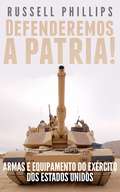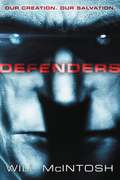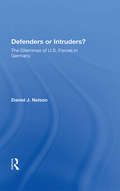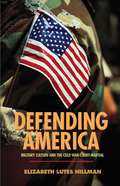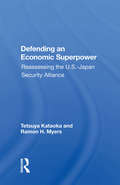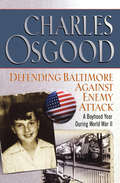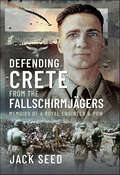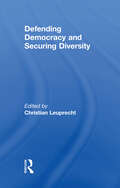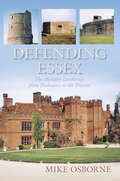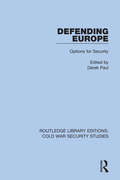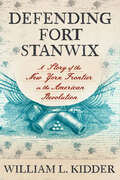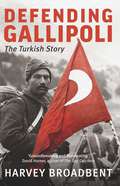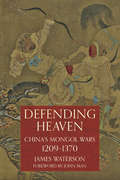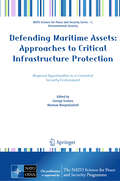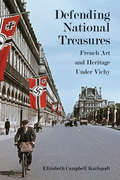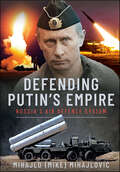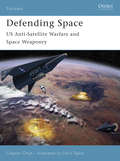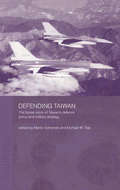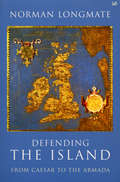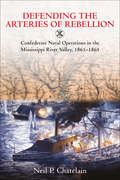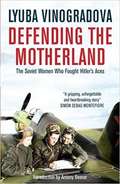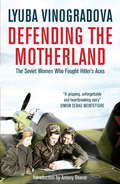- Table View
- List View
Defenderemos a Pátria!: Armas e Equipamento do Exército dos Estados Unidos
by Russel PhillipsO exército dos Estados Unidos é a mais bem equipada força em toda a história militar, desde a simples baioneta até às multimilionárias maravilhas tecnológicas como o tanque Abrams M1 e o helicóptero Apache Longbow. "Defenderemos a Pátria!" resume as mais importantes armas e equipamento usado presentemente pelo Exército. Todos os factos, números e imagens neste ebook vêm directamente de fontes sobre o Exército, acessíveis ao público, editadas e registadas de maneira a formar um manual de referência sucinto, fácil de usar mas altamente informativo.
Defenders
by Will McintoshA new epic of alien invasion and human resistance by Hugo Award-winning author Will McIntosh. Our Darkest Hour.Our Only Hope.The invaders came to claim earth as their own, overwhelming us with superior weapons and the ability to read our minds like open books. Our only chance for survival was to engineer a new race of perfect soldiers to combat them. Seventeen feet tall, knowing and loving nothing but war, their minds closed to the aliens. But these saviors could never be our servants. And what is done cannot be undone.
Defenders Or Intruders?: The Dilemmas Of U.s. Forces In Germany
by Daniel J. NelsonFollowing Dr. Nelson’s A History of U.S. Military Forces in Germany; this book examines contemporary socioeconomic problems created by the stationing of U.S. troops in West Germany (FRG). The issues are magnified by the FRG’s strategic importance to the United States, the large number of U.S. troops stationed in the FRG, and the length of time they
Defending America: Military Culture and the Cold War Court-Martial (Politics and Society in Modern America #140)
by Elizabeth Lutes HillmanFrom going AWOL to collaborating with communists, assaulting fellow servicemen to marrying without permission, military crime during the Cold War offers a telling glimpse into a military undergoing a demographic and legal transformation. The post-World War II American military, newly permanent, populated by draftees as well as volunteers, and asked to fight communism around the world, was also the subject of a major criminal justice reform. By examining the Cold War court-martial, Defending America opens a new window on conflicts that divided America at the time, such as the competing demands of work and family and the tension between individual rights and social conformity. Using military justice records, Elizabeth Lutes Hillman demonstrates the criminal consequences of the military's violent mission, ideological goals, fear of homosexuality, and attitude toward racial, gender, and class difference. The records also show that only the most inept, unfortunate, and impolitic of misbehaving service members were likely to be prosecuted. Young, poor, low-ranking, and nonwhite servicemen bore a disproportionate burden in the military's enforcement of crime, and gay men and lesbians paid the price for the armed forces' official hostility toward homosexuality. While the U.S. military fought to defend the Constitution, the Cold War court-martial punished those who wavered from accepted political convictions, sexual behavior, and social conventions, threatening the very rights of due process and free expression the Constitution promised.
Defending An Economic Superpower: Reassessing The U.s.-japan Security Alliance
by Tetsuya KataokaThis book describes the reassessment of the U.S.-Japan security relationship to determine how Japan can do more for its defense, reduce America's spending for Japan's and Asia's security, yet preserve the peace in that region. It raises six questions about the relationship and tries to answer them.
Defending Baltimore Against Enemy Attack
by Charles Osgood1942. the nation is reeling from the first blows of World War II, nine-year-old Charlie spends his days planting victory gardens, collecting scrap metal, going to ball games and goofing around.
Defending Baltimore Against Enemy Attack: A Boyhood Year During World War II
by Charles OsgoodFrom beloved broadcaster Charles Osgood, a poignant memoir about one unforgettable childhood year during World War II. Defending Baltimore Against Enemy Attack is a gloriously funny and nostalgic slice of American life and a moving look at World War II from the perspective of a child far away from the fighting, but very conscious of the reverberations. With a sharp eye for details, Osgood captures the texture of life in a bygone era.
Defending Britain's Skies, 1940–1945 (Despatches from the Front)
by Martin Mace John GrehanDespatches in this volume include that on the Battle of Britain, and air fighting 1940-1941, by Air Chief Marshal Sir Hugh C.T. Dowding, Air Officer Commanding-in-Chief, Fighter Command, Air Operations by Fighter Command between November 1940 and the end of December 1941, the anti-aircraft defence of the United Kingdom between 1939 and 1945, and the report on air operations by Air Defence of Great Britain and Fighter Command in connection with the German flying bomb and rocket offensives, 1944-1945.This unique collection of original documents will prove to be an invaluable resource for historians, students and all those interested in what was one of the most significant periods in British military history.
Defending Crete from the Fallschirmjagers: Memoirs of a Royal Engineer & POW
by Andrew G. Taylor Jack SeedBy the spring of 1941, the enemy had taken much of Southern Europe: Bulgaria, Yugoslavia, Albania, Greece, and with Italy in the Axis it stood to dominate. The powerful British Naval Fleet and the amassed allied infantry of Britain, New Zealand, Australia, disposed Greeks, and the good people of Crete stood between the Axis powers and total control of the Mediterranean. This is the story of a soldier involved in the defense of Crete. The Luftwaffe commanded the air with their Stuka, Junkers and the formidable German Paratroopers: the Fallschirmjäger. It begins with Jack Seed’s part, as a Royal Engineer, in the Balkan Campaign of 1941. Starting with an account of the defense of Crete, it tells of the retreat from an overpowering enemy and of a determined survival until the victorious moments of the war’s end. Along with his comrades, Jack was taken prisoner of war and moved from Stalag to Stalag in railway trucks, enduring terrible hardships at the hands of his German captors for four years. With barely enough food to keep body and soul together, he and his fellow captives were sent out in gangs to work, often in perishingly cold conditions. They devised ways of getting extra food, but their schemes were often discovered by the German guards. They burnt the wood from their bunks in order to keep warm at night. They grew weak and weary and wondered how much more hardship they could stand. But finally, Hitler was dead, Germany had surrendered and the war was over. Within days, Jack was bound for home, flying over the white cliffs of Dover. He had survived. Jack Seed wrote his Second World War memoir during the 1970s, typing two copies for posterity on a mechanical typewriter. Like many with such experiences, his writing was not for any notion of reward, but to formalise his own lasting experience of the Second World War. Now, almost eighty years later, that story is shared.
Defending Democracy and Securing Diversity
by David Mason Christian Leuprecht Alan Okros Lindy Heinecken Christopher Dandeker David Last Victoria Marie Basham Karen D. Davis Jelle van den Berg Rudy Richardson Liora Sion Anne Irwin Joan Mars NoëLle Van Der Wagg-Cowling Donna WinslowOld sergeants say, "we're here to defend democracy, not to practice it!" But are they right? The special mandate with which defence and security organizations are tasked imposes unique constraints with respect to the accommodation of diversity which differs from those faced by any other public or private organization. Yet, the compound effect of demographic, political, economic, social and legal pressures is making diversity as inevitable in the defence and security sector as in any other organization in advanced industrialized democracies. Owing in part to a dearth of research on the way the defence and security sectors can leverage diversity to enhance their functional imperatives, such sectors have been reticent about diversity. The chapters in this volume strive to enlighten the debate by laying out the concepts, clarifying theoretical issues, and providing empirical evidence. The case studies draw on Canada, Guyana, the Netherlands, South Africa, and the United Kingdom. They examine ethno-cultural, gender, and sexual-minority diversity in a variety of missions, including Bosnia-Herzegovina and Afghanistan. The chapters are notable for their methodological pluralism and interdisciplinary range including political science, sociology, anthropology, and psychology. Although scholarly in nature, the book is readily accessible to professionals and practitioners alike. This book was published as a special issue of Commonwealth and Comparative Politics.
Defending Essex: The Military Landscape from Prehistory to the Present
by Mike OsborneFor 2,000 years Essex, the county with the longest coast-line in England and dominating the eastern approaches to London, has been in the front-line against foreign invasion, from the Romans to the Spanish Armada to the two World Wars. It has also been involved in civil disorder, from the Anarchy and the Peasants’ Revolt to the English Civil War. Many reminders of these scenes of conflict may be seen in the landscape - Iron Age forts, a Roman walled town, medieval castles, strong-houses and homestead moats, coastal fortifications from Napoleonic times and earlier, and Victorian barracks and the drill halls of the Volunteers. From the twentieth century there are still more sites: military airfields from the First World War and Battle of Britain fighter airfields, radar sites and later bomber bases from the Second. Anti-invasion defenses line the coast, linear defenses criss-cross the landscape, and AA sites are everywhere to be found. Taking the story all the way up to the nuclear threat of the Cold War, this guide will interest residents and visitors alike.
Defending Europe: Options for Security (Routledge Library Editions: Cold War Security Studies #21)
by Derek PaulThis book, first published in 1985, examines the questions of European security that lie at the heart of the confrontation between the superpowers. It concentrates on ways of achieving defence by conventional means rather than a reliance on nuclear or chemical weapons, and at the same time focuses on possible force reductions.
Defending Fort Stanwix: A Story of the New York Frontier in the American Revolution
by William L. KidderIn Defending Fort Stanwix, William L. Kidder tells the dramatic story of "the fort that never surrendered" and the crucial role it played in the American War for Independence. After a series of military defeats over the winter of 1776–1777, British military leaders developed a bold plan to gain control of the Hudson River and divide New England from the rest of the colonies. Three armies would converge on Albany: one under Lieutenant General John Burgoyne moving south from Quebec, one under General William Howe moving north from New York City, and a third under Lieutenant Colonel Barrimore St. Leger cutting east from Lake Ontario along the Mohawk River. Fort Stanwix lay directly on the path of St. Leger's force, making it a key defensive position for the Continental Army. By delaying St. Leger's troops and forcing a retreat, the garrison's stand at Fort Stanwix contributed to Burgoyne's surrender at the Battles of Saratoga a month later, a major turning point in the course of the war.Kidder offers an engaging account of life in and around the fort in the months leading up to the siege, detailing the lives of soldiers and their families, civilians, and the Haudenosaunee peoples with a focus on both the mundane aspects of military life and the courageous actions that earned distinction. Defending Fort Stanwix relates the stories of local men and women, both white and Indian, who helped with the fort's defense before, during, and after the siege and showcases an exciting, overlooked story of bravery and cooperation on New York's frontier during the American Revolution.
Defending Gallipoli: The Turkish Story
by Harvey BroadbentBased on exclusive access to Turkish archives, Defending Gallipoli reveals how the Turks reacted and defended Gallipoli. Author and Turkish language expert Harvey Broadbent spent five years translating everything from official records to soldiers' personal diaries and letters to unearth the Turkish story. It is chilling and revealing to see this famous battle in Australian history through the 'enemy' lens. The book commences with a jihad, which sees the soldiers fighting for country and God together. But it also humanises the Turkish soldiers, naming them, revealing their emotions, and ultimately shows how the Allies totally misunderstood and underestimated them Defending Gallipoli fills a huge gap in the history of the Gallipoli campaign.
Defending Heaven: China's Mongol Wars, 1209-1370
by James Waterson&“A very readable account of the protracted and ultimately unsuccessful efforts of the Song, Xia, and Jin dynasties to defend China from the Mongols.&”—StrategyPage Defending Heaven brings together, for the first time in one volume, the complete histories of the wars the Jin, Song, Xia, and Ming dynasties fought against the Mongols. Lasting nearly two centuries, these wars, fought to defend Chinese civilization against a brutal and unrelenting foe, pitted personal heroics against the inexorable Mongol war machine and involved every part of the Chinese state. The resistance of the Chinese dynasties to the Khans is a complex and rich story of shifting alliances and political scheming, vast armies and navies, bloody battles and an astonishing technological revolution. The great events of China&’s Mongol war are described and analyzed, detailing their immediate and later implications for Chinese history. In this excellent new book, James Waterson tackles this fascinating subject with characteristic verve and skill. Setting the Mongol war in the wider context of China&’s ancient and almost perpetual conflict with the northern nomads, it sheds light on the evolution of China&’s military society and the management, command, and control of the army by the Chinese state. &“An excellent contribution not only to the study of the Mongol Empire but also to military history . . . Anyone interested in medieval warfare will find Defending Heaven of interest.&”—Professor Timothy May, in De Re Militari
Defending Maritime Assets: Approaches to Critical Infrastructure Protection (NATO Science for Peace and Security Series C: Environmental Security)
by George Scutaru Murman MargvelashviliThe conflict in Ukraine has thrust the Black Sea into the center of the largest European dispute since 1945, leading to significant consequences for both the Alliance and the countries neighboring the Black Sea. The Kremlin's strategic use of energy resources has disrupted the flow of hydrocarbons, which remained untouched even during the tensest moments of the Cold War. Simultaneously, the potential for offshore energy sources in the Black Sea presents an opportunity for the region to achieve greater energy independence. This could be realized in the short term through oil and gas, as well as in the long term through the development of renewable energy sources. These prospects coincide with a volatile security environment in the Black Sea region. While military actions have escalated in the Northern Black Sea, countries along the coast such as Georgia and Romania have been confronted with Russian New Generation Warfare tactics since the annexation of Crimea in 2014. Since 2017, Russian military exercises have effectively blocked access to the Black Sea, employing legal strategies as part of their approach. This has led to a blurring of the lines between traditional notions of hot and cold wars. The Gerasimov doctrine and incidents like the Nord Stream sabotage have underscored the fact that critical energy infrastructure is no longer off-limits, and the unique characteristics of maritime infrastructure have turned it into a new arena in the realm of hybrid warfare
Defending National Treasures
by Elizabeth Campbell KarlsgodtDefending National Treasuresexplores the fate of art and cultural heritage during the Nazi occupation of France. The French cultural patrimony was a crucial locus of power struggles between German and French leaders and among influential figures in each country. Karlsgodt examines the preservation policy that the Vichy regime enacted in an assertion of sovereignty over French art museums, historic monuments, and archeological sites. The limits to this sovereignty are apparent from German appropriations of public statues, Jewish-owned art collections, and key "Germanic" works of art from French museums. A final chapter traces the lasting impact of the French wartime reforms on preservation policy. InDefending National Treasures, Karlsgodt introduces the concept ofpatrimaniato reveal examples of opportunism in art preservation. During the war, French officials sought to acquire coveted artwork from Jewish collections for the Louvre and other museums; in the early postwar years, they established a complicated guardianship over unclaimed art recovered from Germany. A cautionary tale for our own times,Defending National Treasuresexamines the ethical dimensions of museum acquisitions in the ongoing noble quest to preserve great works of art.
Defending Putin's Empire: Russia’s Air Defence System
by Mihajlo S. MihajlovicCompiled from various sources, some still classified, and many of which have never previously been published, this book clearly portrays the development of the Russian air and ballistic missile defense systems. During the Cold War, the Soviet Union invested heavily in its air defense systems. As a result, Russia now possesses the most advanced air and ballistic missile defense systems in the world. Russian air defense systems are also highly proliferated and are currently in use by many countries. Since the end of the Cold War and the breakup of the USSR, it has become increasingly possible to study Russian air defense, but Russia is by no means an open book on defense-related subjects. Some information circulates in the media, but for the time being, air defense systems are still subject to a degree of speculation. Air and ballistic missile defense programs in the Soviet Union and Russia have a very long history. Soviet engineers started working on both programs in the 1950s, and by 1960 they had built the first successful systems able to intercept enemy aircraft and intermediate-range ballistic missiles. Current Russian air defense doctrine follows a layered multi-level approach providing in depth coverage from any aerial or ballistic missile attack. This layered system allows Russian air defense forces to create zones that can be very difficult to penetrate. The highest level of these defensive networks uses long-range systems providing air defense umbrellas potentially up to 500+ km. The second level includes medium-range systems like the S-350 and Buk variants (infamous for downing Malaysian Airline’s flight MH17 over the Ukraine in 2014). This medium-range level is intended to provide air defense zones which are also covered under the long-range systems but are more cost-effective in this envelope. The third level presents mobile short-range systems which are intended to provide extra protection for the long-range systems as well as stationary objects. These systems, along with highly mobile systems like the Buk are often also attached to ground forces formations such as armored and mechanized divisions and brigades. What are the abilities of these systems against NATO? President Putin emphasized the need to strengthen the country’s air defenses amid NATO’s military activities near Russia’s borders. One of the key new concept developments is counter-stealth detection and interception. The other is to counter future hypersonic missile threats. It is, as the author reveals, Russia that is leading the way in these races.
Defending Space
by Clayton Chun Chris TaylorThe United States has been developing space for many years, and satellites provide the US military with an unparalleled advantage over adversaries. Constellations of both military and civilian satellites provide protection and support for military operations, deliver ballistic missile early warning, supply reliable, secure and jam-proof communications, gather audio-visual amd electronic intelligence, predict weather patterns, guide navigation, target weapons, and perform a host of other missions. These systems are critical to America's status as a world power, and potential threats to them are carefully assessed by US military planners. In January 2001, a commission led by Donald Rumsfeld warned of the growing threat to US space assets from so-called "rogue states," who (with varying degrees of difficulty) might build and deploy "space mines", launch ballistic anti-satellite weapons, deliberately increase orbital debris or detonate high-altitude nuclear explosions. The defensive options currently available to the US include improving satellite defenses (making them more robust and maneuverable, and improving threat detection) and the controversial placing of weapons in space (in "sentinel satellites") to protect military and civilian hardware. Since the 1950s research and development has been applied to space weaponry with mixed results, and not only by the USA. This book explains the origin and development of systems used to defend the United States from past, present and future threats, and to support military operations.
Defending Taiwan: The Future Vision of Taiwan's Defence Policy and Military Strategy
by Martin Edmonds Michael M. TsaiRecent concern about mainland China's intentions towards Taiwan, and more general concern about the risk of instability in the region, has led to growing interest in Taiwan's military strategy, in how Taiwan perceives threats to itself, and in how the Taiwanese military are reacting to these perceived threats. This book, which includes contributions by leading Taiwanese military thinkers, explores current military strategy in Taiwan and how it is evolving. It discusses Taiwan's military modernisation, and the implications of the recent defeat after fifty years in power of the Kuomintang Party, implications which include a move away from an authoritarian garrison state culture, and the beginnings of a more open debate about defence. The book concludes with an overall appraisal of Taiwan's defence vision and makes recommendations on how Taiwan's defence might be enhanced.
Defending The Island: From Caesar to the Armada
by Norman LongmateIn a brilliantly imaginative blend of military, social and diplomatic history, Norman Longmate retells our island story from the perspective of its defenders, in a narrative which stretches from the Celtic tribes who unsuccessfully fought against Ceasar to the great seabourne defence against the Armada of Philip of Spain. He has gone back to the original sources and investigated the original battlegrounds and weak spots in Britain's defences. But the real strength of his book is its seamless narrative of history, which uncovers the truth behind the legends. A mass of solidly researched fact, not readily found elsewhere, is seasoned with lively, humorous and occassionally gruesome anecdote. The result, providing at once an invaluable sourcebook for the specialist and an enthralling narrative for the general reader, is by far the most comprehensive and accessible history of England versus invasion ever published.
Defending the Arteries of Rebellion: Confederate Naval Operations in the Mississippi River Valley, 1861–1865
by Neil P. ChatelainThis thorough account of the South’s efforts to hold the Mississippi River is “fast-paced, easy to read, and well supported by archival research”(The Civil War Monitor).Most studies of the Mississippi River focus on Union campaigns to open and control it, while overlooking Southern attempts to stop them. This book tells the other side of the story—the first modern full-length treatment of inland naval operations from the Confederate perspective.Jefferson Davis realized the value of the Mississippi River and its entire valley, which he described as the “great artery of the Confederacy.” This was the key internal highway that controlled the fledgling nation’s transportation network. Davis and his secretary of the navy knew these vital logistical paths offered potential highways of invasion for Union warships and armies to stab their way deep into the heart of the Confederacy, and had to be held.They planned to protect these arteries of rebellion by crafting a ring of powerful fortifications supported by naval forces. Different military branches, however, including the navy, marine corps, army, and revenue service, as well as civilian privateers and even state naval forces, competed for scarce resources to operate their own vessels. A lack of industrial capacity further complicated Confederate efforts and guaranteed the South’s grand vision of deploying dozens of river gunboats and powerful ironclads would never be fully realized.Despite these limitations, the Southern war machine introduced many innovations and alternate defenses including the Confederacy’s first operational ironclad, the first successful use of underwater torpedoes, widespread use of army-navy joint operations, and the employment of extensive river obstructions. When the river came under complete Union control in 1863, Confederate efforts shifted to its many tributaries, and a bitter, deadly struggle to control these internal lifelines. Despite a lack of ships, material, personnel, funding, and unified organization, the Confederacy fought desperately and scored many localized tactical victories—often at great cost—but failed at the strategic level.Written by a former Navy Surface Warfare Officer, this study, grounded in extensive archival and firsthand accounts, official records, and a keen understanding of terrain and geography, “very astutely gets to the heart of the main internal factors that lay behind the CSN's catastrophic failure to defend the strategic waterways of the Mississippi River Valley” (Civil War Books and Authors).
Defending the Constitution behind Enemy Lines: A Story of Hope for Those Who Love Liberty (Children’s Health Defense)
by Robert A. Green Jr.The story of a silenced minority who put their constitutional oaths before all else to keep our Founding Fathers' great gift of liberty alive. Defending the Constitution Behind Enemy Lines is an explosive, tell-all book, detailing the military COVID-19 vaccine mandate, and the resistance to that mandate by service members who could not, in good conscience, go along. As an actively serving Navy Commander, Robert A. Green Jr. removes the veil of military secrecy and complexity to shed light on the related unlawfulness and the official cover-up being committed by certain DoD leaders. His deep dive into the current crisis details the harms perpetrated against service members and their families as well as the destruction of military readiness that resulted. Standing upon his First Amendment rights, the first-time author analyzes the current crisis in light of the challenges faced by our Founding Fathers. His message to the American people is clear: The crisis our military is facing will only be solved by following in the footsteps of our Founding Fathers and returning to an adherence to the Constitution that our forebears sacrificed everything to leave us.
Defending the Motherland: The Soviet Women Who Fought Hitler's Aces
by Lyuba VinogradovaPlucked from every background, and led by an N.K.V.D. Major, the new recruits who boarded a train in Moscow on 16th October 1941 to go to war had much in common with millions of others across the world. What made the 586th Fighter Regiment, the 587th Heavy-bomber Regiment and the 588th Regiment of light night-bombers unique was their gender: the Soviet Union was creating the first all-female active combat units in modern history.Drawing on original interviews with surviving airwomen, Lyuba Vinogradova weaves together the untold stories of the female Soviet fighter pilots of the Second World War. From that first train journey to the last tragic disappearance, Vinogradova's panoramic account of these women's lives follows them from society balls to unmarked graves, from landmark victories to the horrors of Stalingrad. Battling not just fearsome Aces of the Luftwaffe but also patronising prejudice from their own leaders, women such as Lilya Litvyak and Ekaterina Budanova are brought to life by the diaries and recollections of those who knew them, and who watched them live, love, fight and die.
Defending the Motherland: The Soviet Women Who Fought Hitler's Aces
by Lyuba VinogradovaPlucked from every background, and led by an N.K.V.D. Major, the new recruits who boarded a train in Moscow on 16th October 1941 to go to war had much in common with millions of others across the world. What made the 586th Fighter Regiment, the 587th Heavy-bomber Regiment and the 588th Regiment of light night-bombers unique was their gender: the Soviet Union was creating the first all-female active combat units in modern history.Drawing on original interviews with surviving airwomen, Lyuba Vinogradova weaves together the untold stories of the female Soviet fighter pilots of the Second World War. From that first train journey to the last tragic disappearance, Vinogradova's panoramic account of these women's lives follows them from society balls to unmarked graves, from landmark victories to the horrors of Stalingrad. Battling not just fearsome Aces of the Luftwaffe but also patronising prejudice from their own leaders, women such as Lilya Litvyak and Ekaterina Budanova are brought to life by the diaries and recollections of those who knew them, and who watched them live, love, fight and die.
